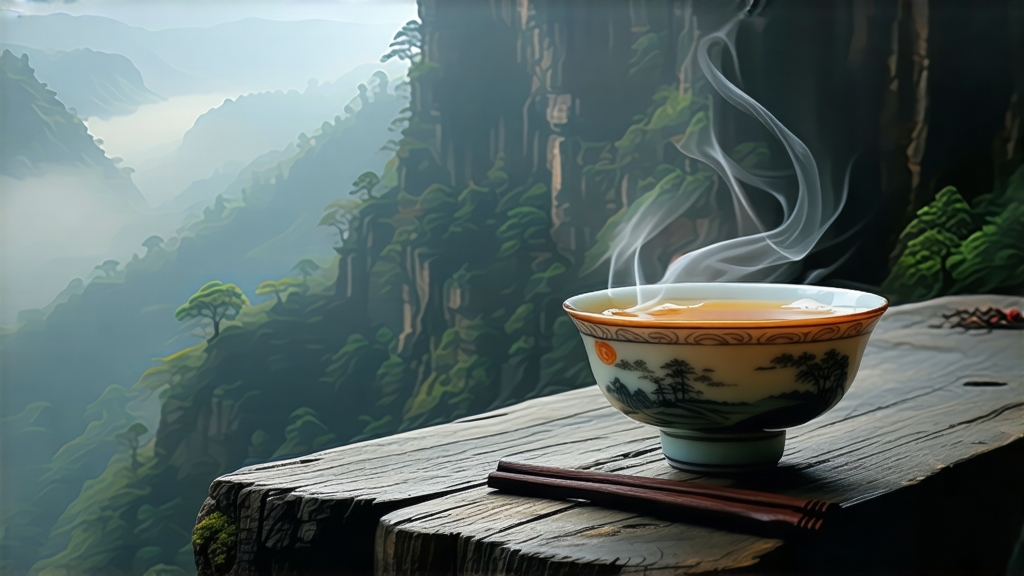
If green tea is the youthful face of Chinese tea culture, then Wuyi Da Hong Pao is its weather-beaten, poetry-spouting elder—an oolong that carries the scent of pine smoke, the memory of Tang-dynasty monks, and the flinty breath of cliffs that have been baking in the Fujian sun for 300 million years. International drinkers often meet oolong through lightly oxidized Taiwanese high-mountains; Da Hong Pao offers the opposite pole—deep oxidation, heavy roasting, and a finish that tastes like river stones dipped in honey. To understand it is to step into the myth-soaked gorges of Mount Wuyi, a UNESCO double world-site for both culture and nature, where nine-bend bamboo rafts still glide past temples carved into rock and every bend of the river exhales tea fragrance.
Legend first. During the Ming dynasty, a jinshi scholar on his way to the capital fell gravely ill at the foot of Wuyi’s Nine-Dragon Gorge. A passing monk from Tianxin Temple brewed leaves picked from nearby bushes, revived the traveler, and sent him on to earn the highest imperial degree. Grateful, the scholar returned in crimson official robes to thank his benefactors; he draped the scarlet silk over the tea bushes to protect them from frost, and the name “Big Red Robe” was born. Imperial records show that by 1607 the court had designated these bushes as tribute tea; only 35 grams reached the Forbidden City each year, carried by soldiers who changed horses every ten li to keep the leaves fresh. Today the mother trees—six ancient bushes clinging to a 30-meter vertical cliff—are preserved, not harvested, and insured for more than their weight in gold.
Botanically, Da Hong Pao belongs to the Wuyi qi zhong (“strange cultivar”) family, a gene pool of more than 200 local bushes evolved from Camellia sinensis var. sinensis. The four most celebrated clones—separated in the 1980s through asexual cuttings—are named Que She (Sparrow Tongue), Bei Dou (North Star), Qi Dan (Original Red), and the now-dominant commercial strain Da Hong Pao #1. Each differs slightly in leaf chemistry: Que She carries higher linalool for orchid top notes, Bei Dou has more geraniol giving rose accents, while the standard clone balances catechins and tannins for the signature “rock rhyme” (yanyun) that Chinese tasters describe as the taste of the mountain itself.
Making Da Hong Pao is a three-week marathon that starts under starlight. Pickers climb bamboo ladders fastened to the cliff face at 3 a.m., when leaf turgor is highest and mountain mist is thickest. Two leaves and a bud are snapped, never cut, to keep the vein intact; 4 kg of fresh leaf will yield only 1 kg of finished tea. Withering begins on bamboo racks inside a Qing-dynasty building whose slate roof has turned black from decades of smoke. Here the leaves lose 15 % moisture in cool mountain air until the edges feel like wet silk. Tumblers heated to 220 °C provide the “killing-green” shock; masters toss the leaves by hand, judging the exact second when the grassy note vanishes and a baked-bread aroma appears. Oxidation follows in linen-lined baskets kept at 28 °C and 75 % humidity. Every 45 minutes the tea is rocked—lift, shake, settle—so that cell walls bruise evenly; the leaf edges turn chestnut while the veins stay green, the visual signature of 50 % oxidation. When the master smells ripe peach and copper pennies, firing begins.
Charcoal roasting is the soul step. A pit is dug into the sandstone floor; longan or lychee wood is burned down to embers, then covered with a 10 cm layer of white ash to moderate heat. Woven bamboo trays holding two liang (100 g) of tea are stacked seven high above the pit; temperature is read not with thermometers but by sprinkling water on the tray—if it dances for three seconds, the heat is right. Over 8–12 hours the tea is turned every 20 minutes; the process is repeated two more times with resting periods of 40 days between each roast. In the end the leaf moisture drops to 3 %, and volatile arom